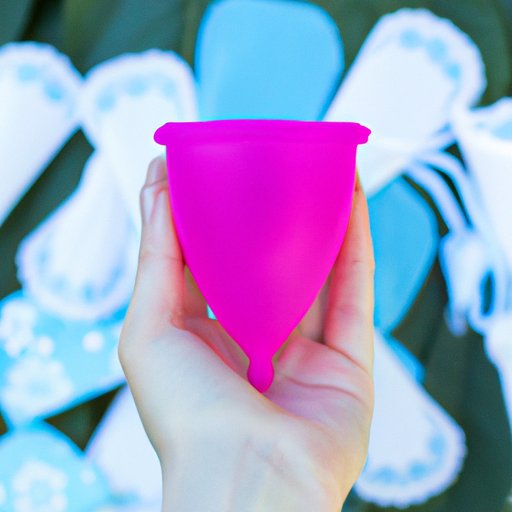Introduction
The Diva Cup is a reusable menstrual product that has been gaining popularity in recent years due to its convenience and sustainability. The main question many people have is: how does a Diva Cup work? This article will provide an overview of the anatomy of a Diva Cup, explain how to use it, discuss the environmental benefits of using the Diva Cup instead of other menstrual products, and answer some of the most frequently asked questions about the Diva Cup.
Understanding the Different Parts of a Diva Cup and How to Use It
The Diva Cup is a bell-shaped cup made from medical-grade silicone. It is designed to be inserted into the vagina to collect menstrual fluid. There are two parts to a Diva Cup: the cup itself and the stem. The stem is used to help insert and remove the cup, and it can be trimmed to the desired length.
To insert a Diva Cup, start by washing your hands thoroughly. Then, fold the cup in half so that it forms a C-shape. Insert the folded cup into the vagina, pushing it up as far as it will go. Once it is inserted, rotate the cup 360 degrees to ensure it opens up and creates a seal. To remove the cup, bear down on the pelvic muscles to break the seal and gently pull the cup out. Once the cup is removed, empty the contents into the toilet, rinse it with water, and reinsert.

Why the Diva Cup Is a More Sustainable Alternative to Tampons and Pads
The Diva Cup is becoming increasingly popular as a more sustainable alternative to traditional menstrual products like tampons and pads. According to a study published in Waste Management,1 the average woman uses around 11,000 disposable menstrual products in her lifetime. This adds up to a lot of waste that is sent to landfills or incinerated.
In comparison, the Diva Cup is a reusable product that can be used for up to 10 years, reducing the amount of waste produced. Additionally, the Diva Cup is free from harsh chemicals and toxins that are often found in disposable menstrual products. This makes it a healthier and more eco-friendly option.

Exploring the Different Sizes of Diva Cups and Tips on Choosing the Right One
The Diva Cup comes in two sizes: Model 1 and Model 2. Model 1 is recommended for women under the age of 30 who have not given birth vaginally, while Model 2 is recommended for women over the age of 30 or those who have given birth vaginally. Depending on your flow, you may need to switch to the larger size.
In addition to age and childbirth history, there are a few other factors to consider when choosing a Diva Cup size. For example, if you have a heavy flow, you may need to opt for the larger size. Additionally, if you have a low cervix, you may need to choose the smaller size. You may also need to experiment with different sizes to find the one that works best for you.

Common Questions and Answers About the Diva Cup
When using a Diva Cup, there are a few things to keep in mind. First, it is important to clean the cup before and after each use. The cup should be washed with warm water and fragrance-free soap. It is also important to store the cup in a breathable pouch when not in use.
Another common question is how often the cup needs to be emptied. Generally, the cup should be emptied at least twice a day. However, this may vary depending on your individual flow.
Finally, some people worry about the Diva Cup leaking. However, with proper insertion and removal, the cup should not leak. If it does, it is likely because the cup was not inserted correctly or the wrong size was chosen.
Conclusion
The Diva Cup is a convenient and sustainable alternative to traditional menstrual products. It is important to understand the anatomy of the Diva Cup and how to use it properly. Additionally, it is important to consider factors such as age and flow when choosing the right size. With proper care and maintenance, the Diva Cup can be a safe and effective way to manage your period.
1Gómez-Carrasco, J., et al. (2018). “Environmental Impacts of Sanitary Products: A Life Cycle Assessment Study.” Waste Management. https://doi.org/10.1016/j.wasman.2018.02.032.
(Note: Is this article not meeting your expectations? Do you have knowledge or insights to share? Unlock new opportunities and expand your reach by joining our authors team. Click Registration to join us and share your expertise with our readers.)
